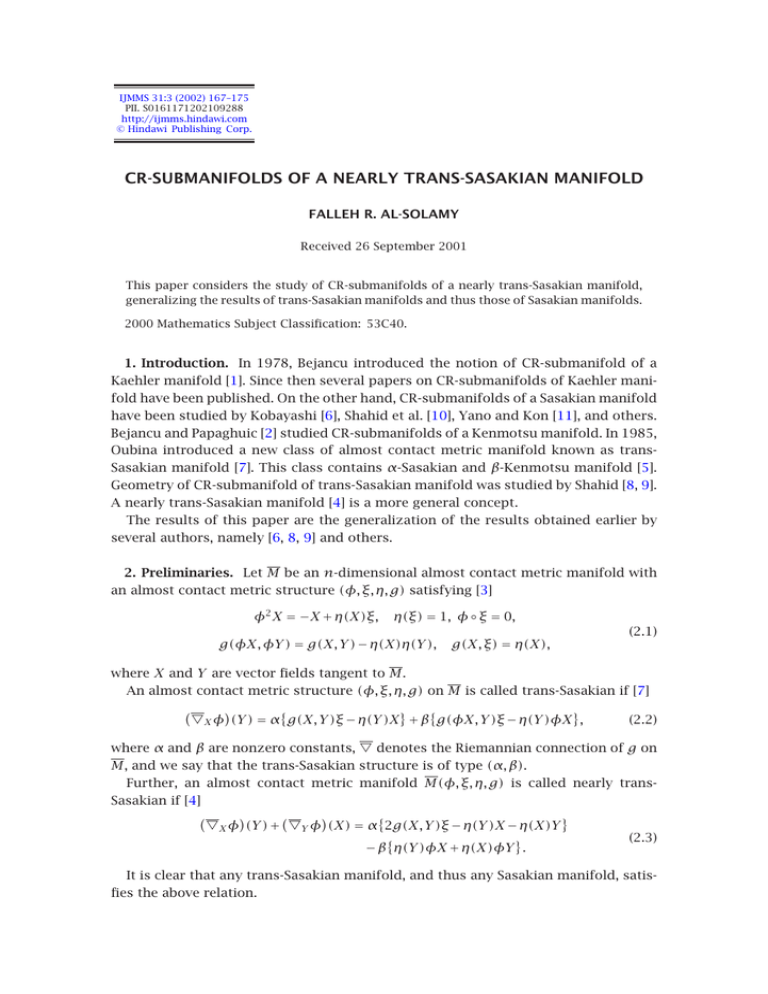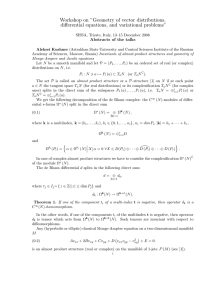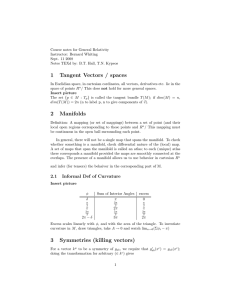CR-SUBMANIFOLDS OF A NEARLY TRANS-SASAKIAN MANIFOLD FALLEH R. AL-SOLAMY
advertisement

IJMMS 31:3 (2002) 167–175 PII. S0161171202109288 http://ijmms.hindawi.com © Hindawi Publishing Corp. CR-SUBMANIFOLDS OF A NEARLY TRANS-SASAKIAN MANIFOLD FALLEH R. AL-SOLAMY Received 26 September 2001 This paper considers the study of CR-submanifolds of a nearly trans-Sasakian manifold, generalizing the results of trans-Sasakian manifolds and thus those of Sasakian manifolds. 2000 Mathematics Subject Classification: 53C40. 1. Introduction. In 1978, Bejancu introduced the notion of CR-submanifold of a Kaehler manifold [1]. Since then several papers on CR-submanifolds of Kaehler manifold have been published. On the other hand, CR-submanifolds of a Sasakian manifold have been studied by Kobayashi [6], Shahid et al. [10], Yano and Kon [11], and others. Bejancu and Papaghuic [2] studied CR-submanifolds of a Kenmotsu manifold. In 1985, Oubina introduced a new class of almost contact metric manifold known as transSasakian manifold [7]. This class contains α-Sasakian and β-Kenmotsu manifold [5]. Geometry of CR-submanifold of trans-Sasakian manifold was studied by Shahid [8, 9]. A nearly trans-Sasakian manifold [4] is a more general concept. The results of this paper are the generalization of the results obtained earlier by several authors, namely [6, 8, 9] and others. 2. Preliminaries. Let M be an n-dimensional almost contact metric manifold with an almost contact metric structure (φ, ξ, η, g) satisfying [3] φ2 X = −X + η(X)ξ, η(ξ) = 1, φ ◦ ξ = 0, g(φX, φY ) = g(X, Y ) − η(X)η(Y ), g(X, ξ) = η(X), (2.1) where X and Y are vector fields tangent to M. An almost contact metric structure (φ, ξ, η, g) on M is called trans-Sasakian if [7] X φ (Y ) = α g(X, Y )ξ − η(Y )X + β g(φX, Y )ξ − η(Y )φX , (2.2) where α and β are nonzero constants, denotes the Riemannian connection of g on M, and we say that the trans-Sasakian structure is of type (α, β). Further, an almost contact metric manifold M(φ, ξ, η, g) is called nearly transSasakian if [4] X φ (Y ) + Y φ (X) = α 2g(X, Y )ξ − η(Y )X − η(X)Y (2.3) − β η(Y )φX + η(X)φY . It is clear that any trans-Sasakian manifold, and thus any Sasakian manifold, satisfies the above relation. 168 FALLEH R. AL-SOLAMY Let M be an m-dimensional isometrically immersed submanifold of a nearly transSasakian manifold M and denote by the same g the Riemannian metric tensor field induced on M from that of M. Definition 2.1. An m-dimensional Riemannian submanifold M of a nearly transSasakian manifold M is called a CR-submanifold if ξ is tangent to M and there exists a differentiable distribution D : x ∈ M → Dx ⊂ Tx M such that (1) the distribution Dx is invariant under φ, that is, φDx ⊂ Dx for each x ∈ M; (2) the complementary orthogonal distribution D ⊥ : x ∈ M → Dx⊥ ⊂ Tx M of D is anti-invariant under φ, that is, φDx⊥ ⊂ Tx⊥ M for all x ∈ M, where Tx M and Tx⊥ M are the tangent space and the normal space of M at x, respectively. If dim Dx⊥ = 0 (resp., dim Dx = 0), then the CR-submanifold is called an invariant (resp., anti-invariant) submanifold. The distribution D (resp., D ⊥ ) is called the horizontal (resp., vertical) distribution. Also, the pair (D, D ⊥ ) is called ξ-horizontal (resp., vertical) if ξx ∈ Dx (resp., ξx ∈ Dx⊥ ) [6]. For any vector field X tangent to M, we put [6] X = P X + QX, (2.4) ⊥ where P X and QX belong to the distribution D and D . For any vector field N normal to M, we put [6] φN = BN + CN, (2.5) where BN (resp., CN) denotes the tangential (resp., normal) component of φN. Let (resp., ) be the covariant differentiation with respect to the Levi-Civita connection on M (resp., M). The Gauss and Weingarten formulas for M are respectively given by X Y = X Y + h(X, Y ); X N = −AN X + ⊥ (2.6) X N, for X, Y ∈ T M and N ∈ T ⊥ M, where h (resp., A) is the second fundamental form (resp., tensor) of M in M, and ⊥ denotes the normal connection. Moreover, we have (2.7) g h(X, Y ), N = g AN X, Y . 3. Some basic lemmas. First we prove the following lemma. Lemma 3.1. Let M be a CR-submanifold of a nearly trans-Sasakian manifold M. Then P X φP Y + P Y φP X − P AφQX Y − P AφQY X = φP X Y + φP Y X + 2αg(X, Y )P ξ − αη(Y )P X − αη(X)P Y − βη(Y )φP X + βη(X)φP Y , Q X φP Y + Q Y φP X − Q AφQX Y − Q AφQY X = 2Bh(X, Y ) − αη(Y )QX − αη(X)QY + 2αg(X, Y )Qξ, ⊥ h(X, φP Y ) + h(Y , φP X) + ⊥ X φQY + Y φQX = φQ Y X + φQ X Y + 2Ch(X, Y ) − βη(Y )φQX − βη(X)φQY for X, Y ∈ T M. (3.1) (3.2) (3.3) 169 CR-SUBMANIFOLDS OF A NEARLY TRANS-SASAKIAN . . . Proof. From the definition of the nearly trans-Sasakian manifold and using (2.4), (2.5), and (2.6), we get X φP Y + h(X, φP Y ) − AφQY X + ⊥ X φQY − φ X Y + h(X, Y ) + Y φP X + h(Y , φP X) − AφQX Y + ⊥ Y φQX − φ Y X + h(X, Y ) = α 2g(X, Y )ξ − η(Y )X − η(X)Y − β η(Y )φX + η(X)φY (3.4) for any X, Y ∈ T M. Now using (2.4) and equaling horizontal, vertical, and normal components in (3.4), we get the result. Lemma 3.2. Let M be a CR-submanifold of a nearly trans-Sasakian manifold M. Then 2 X φ (Y ) = X φY − Y φX + h(X, φY ) − h(Y , φX) − φ[X, Y ] + α 2g(X, Y )ξ − η(Y )X − η(X)Y − β η(Y )φX + η(X)φY (3.5) for any X, Y ∈ D. Proof. By Gauss formula (2.6), we get X φY − Y φX = X φY + h(X, φY ) − Y φX − h(Y , φX). (3.6) Also, we have X φY − Y φX = X φ (Y ) − Y φ (X) + φ[X, Y ]. (3.7) From (3.6) and (3.7), we get X φ (Y ) − Y φ (X) = X φY + h(X, φY ) − Y φX − h(Y , φX) − φ[X, Y ]. (3.8) Also for nearly trans-Sasakian manifolds, we have X φ (Y ) + Y φ (X) = α 2g(X, Y )ξ − η(Y )X − η(X)Y − β η(Y )φX + η(X)φY . (3.9) Combining (3.8) and (3.9), the lemma follows. In particular, we have the following corollary. Corollary 3.3. Let M be a ξ-vertical CR-submanifold of a nearly trans-Sasakian manifold, then 2 X φ (Y ) = X φY − Y φX + h(X, φY ) − h(Y , φX) − φ[X, Y ] + 2αg(X, Y )ξ (3.10) for any X, Y ∈ D. Similarly, by Weingarten formula (2.6), we get the following lemma. 170 FALLEH R. AL-SOLAMY Lemma 3.4. Let M be a CR-submanifold of a nearly trans-Sasakian manifold M, then ⊥ 2 Y φ (Z) = AφY Z − AφZ Y + ⊥ Y φZ − Z φY − φ[Y , Z] (3.11) + α 2g(Y , Z)ξ − η(Y )Z − η(Z)Y − β η(Y )φZ + η(Z)φY for any Y , Z ∈ D ⊥ . Corollary 3.5. Let M be a ξ-horizontal CR-submanifold of a nearly trans-Sasakian manifold, then ⊥ 2 Y φ (Z) = AφY Z − AφZ Y + ⊥ Y φZ − Z φY − φ[Y , Z] + 2αg(Y , Z)ξ (3.12) for any Y , Z ∈ D ⊥ . Lemma 3.6. Let M be a CR-submanifold of a nearly trans-Sasakian manifold M, then 2 X φ (Y ) = α 2g(X, Y )ξ − η(Y )X − η(X)Y − β η(Y )φX + η(X)φY (3.13) − AφY X + ⊥ X φY − Y φX − h(Y , φX) − φ[X, Y ] for any X ∈ D and Y ∈ D ⊥ . 4. Parallel distributions Definition 4.1. The horizontal (resp., vertical) distribution D (resp., D ⊥ ) is said to be parallel [1] with respect to the connection on M if X Y ∈ D (resp., Z W ∈ D ⊥ ) for any vector field X, Y ∈ D (resp., W , Z ∈ D ⊥ ). Now we prove the following proposition. Proposition 4.2. Let M be a ξ-vertical CR-submanifold of a nearly trans-Sasakian manifold M. If the horizontal distribution D is parallel, then h(X, φY ) = h(Y , φX) (4.1) for all X, Y ∈ D. Proof. Using parallelism of horizontal distribution D, we have X φY ∈ D, Y φX ∈ D for any X, Y ∈ D. (4.2) Thus using the fact that QX = QY = 0 for Y ∈ D, (3.2) gives Bh(X, Y ) = g(X, Y )Qξ for any X, Y ∈ D. (4.3) Also, since φh(X, Y ) = Bh(X, Y ) + Ch(X, Y ), (4.4) then φh(X, Y ) = g(X, Y )Qξ + Ch(X, Y ) for any X, Y ∈ D. (4.5) Next from (3.3), we have h(X, φY ) + h(Y , φX) = 2Ch(X, Y ) = 2φh(X, Y ) − 2g(X, Y )Qξ, (4.6) CR-SUBMANIFOLDS OF A NEARLY TRANS-SASAKIAN . . . 171 for any X, Y ∈ D. Putting X = φX ∈ D in (4.6), we get h(φX, φY ) + h Y , φ2 X = 2φh(φX, Y ) − 2g(φX, Y )Qξ (4.7) h(φX, φY ) − h(Y , X) = 2φh(φX, Y ) − 2g(φX, Y )Qξ. (4.8) or Similarly, putting Y = φY ∈ D in (4.6), we get h(φY , φX) − h(X, Y ) = 2φh(X, φY ) − 2g(X, φY )Qξ. (4.9) Hence from (4.8) and (4.9), we have φh(X, φY ) − φh(Y , φX) = g(X, φY )Qξ − g(φX, Y )Qξ. (4.10) Operating φ on both sides of (4.10) and using φξ = 0, we get h(X, φY ) = h(Y , φX) (4.11) for all X, Y ∈ D. Now, for the distribution D ⊥ , we prove the following proposition. Proposition 4.3. Let M be a ξ-vertical CR-submanifold of a nearly trans-Sasakian manifold M. If the distribution D ⊥ is parallel with respect to the connection on M, then AφY Z + AφZ Y ∈ D ⊥ for any Y , Z ∈ D ⊥ . (4.12) Proof. Let Y , Z ∈ D ⊥ , then using Gauss and Weingarten formula (2.6), we obtain ⊥ − AφZ Y + ⊥ Y φZ − AφY Z + Z φY = φ Y Z + φ Z Y + 2φh(Y , Z) + α 2g(X, Y )ξ − η(Y )Z − η(Z)Y − β η(Y )φZ + η(Z)φY (4.13) for any Y , Z ∈ D ⊥ . Taking inner product with X ∈ D in (4.13), we get g AφY Z, X + g AφZ Y , X = g Y Z, φX + g Z Y , φX . (4.14) If the distribution D ⊥ is parallel, then Y Z ∈ D ⊥ and Z Y ∈ D ⊥ for any Y , Z ∈ D ⊥ . So from (4.14) we get g AφY Z, X + g AφZ Y , X = 0 or g AφY Z + AφZ Y , X = 0 (4.15) which is equivalent to AφY Z + AφZ Y ∈ D ⊥ for any Y , Z ∈ D ⊥ , (4.16) and this completes the proof. Definition 4.4 [6]. A CR-submanifold is said to be mixed totally geodesic if h(X, Z) = 0 for all X ∈ D and Z ∈ D ⊥ . 172 FALLEH R. AL-SOLAMY The following lemma is an easy consequence of (2.7). Lemma 4.5. Let M be a CR-submanifold of a nearly trans-Sasakian manifold M. Then M is mixed totally geodesic if and only if AN X ∈ D for all X ∈ D. Definition 4.6 [6]. A normal vector field N ≠ 0 is called D-parallel normal section if ⊥ X N = 0 for all X ∈ D. Now we have the following proposition. Proposition 4.7. Let M be a mixed totally geodesic ξ-vertical CR-submanifold of a nearly trans-Sasakian manifold M. Then the normal section N ∈ φD ⊥ is D-parallel if and only if X φN ∈ D for all X ∈ D. Proof. Let N ∈ φD ⊥ . Then from (3.2) we have Q Y φX = 0 for any X ∈ D, Y ∈ D ⊥ . (4.17) In particular, we have Q(Y X) = 0. By using it in (3.3), we get ⊥ X φQY = φQ X Y or ⊥ X N = −φQ X φN. (4.18) Thus, if the normal section N ≠ 0 is D-parallel, then using Definition 4.6 and (4.18), we get (4.19) φQ X φN = 0 which is equivalent to X φN ∈ D for all X ∈ D. The converse part easily follows from (4.18). 5. Integrability conditions of distributions. First we calculate the Nijenhuis tensor Nφ (X, Y ) on a nearly trans-Sasakian manifold M. For this, first we prove the following lemma. Lemma 5.1. Let M be a nearly trans-Sasakian manifold, then φX φ (Y ) = 2αg(φX, Y )ξ − η(Y )φX + βη(Y )X − βη(X)η(Y )ξ − η(X)Y ξ + φ Y φ (X) + η Y X ξ (5.1) for any X, Y ∈ T M. Proof. From the definition of nearly trans-Sasakian manifold M, we have φX φ (Y ) = 2αg(φX, Y )ξ − η(Y )φX + βη(Y )X − βη(Y )η(X)ξ − Y φ (φX). (5.2) Also, we have Y φ (φX) = Y φ2 X − φY φX = Y φ2 X − φY φX + φ φY X − φ φY X = −Y X + η(X)Y ξ − φ Y φX − φY X − φ φY X = −Y X + η(X)Y ξ − φ Y φ (X) − Y X − η Y X ξ. (5.3) CR-SUBMANIFOLDS OF A NEARLY TRANS-SASAKIAN . . . Using (5.3) in (5.2), we get φX φ (Y ) = 2αg(φX, Y )ξ − η(Y )φX + βη(Y )X − βη(X)η(Y )ξ − η(X)Y ξ + φ Y φ (X) + η Y X ξ 173 (5.4) for any X, Y ∈ T M, which completes the proof of the lemma. On a nearly trans-Sasakian manifold M, Nijenhuis tensor is given by Nφ (X, Y ) = φX φ (Y ) − φY φ (X) − φ X φ (Y ) + φ Y φ (X) (5.5) for any X, Y ∈ T M. From (5.1) and (5.5), we get Nφ (X, Y ) = 4αg(φX, Y )ξ − η(Y )φX + η(X)φY + βη(Y )X − βη(X)Y − η(X)Y ξ + η(Y )X ξ + η Y X ξ − η X Y ξ + 2φ Y φ (X) − 2φ X φ (Y ). (5.6) Thus using (2.3) in the above equation and after some calculations, we obtain Nφ (X, Y ) = 4αg(φX, Y )ξ + (2α − 1)η(Y )φX + (2α + 1)η(X)φY − βη(Y )X − 3βη(X)Y + 4βη(X)η(Y )ξ − η(X)Y ξ + η(Y )X ξ + η Y X ξ − η X Y ξ + 4φ Y φ (X) (5.7) for any X, Y ∈ T M. Now we prove the following proposition. Proposition 5.2. Let M be a ξ-vertical CR-submanifold of a nearly trans-Sasakian manifold M. Then, the distribution D is integrable if the following conditions are satisfied: S(X, Z) ∈ D, h(X, φZ) = h(φX, Z) (5.8) for any X, Z ∈ D. Proof. The torsion tensor S(X, Y ) of the almost contact structure (φ, ξ, η, g) is given by S(X, Y ) = Nφ (X, Y ) + 2dη(X, Y )ξ = Nφ (X, Y ) + 2g(φX, Y )ξ. (5.9) Thus, we have S(X, Y ) = [φX, φY ] − φ[φX, Y ] − φ[X, φY ] + 2g(φX, Y )ξ (5.10) for any X, Y ∈ T M. Suppose that the distribution D is integrable. So for X, Y ∈ D, Q[X, Y ] = 0 and η([X, Y ]) = 0 as ξ ∈ D ⊥ . If S(X, Y ) ∈ D, then from (5.7) and (5.9) we have 2(2α+1)g(φX, Y )ξ +η [X, Y ] ξ +4 φY φX +φh(Y , φX)+QY X +h(X, Y ) ∈ D (5.11) 174 FALLEH R. AL-SOLAMY or 2(2α+1)g(φX, Y )Qξ+η [X, Y ] Qξ+4 φQY φX+φh(Y , φX)+QY X+h(X, Y ) = 0 (5.12) for any X, Y ∈ D. Replacing Y by φZ for Z ∈ D in the above equation, we get 2(2α + 1)g(φX, φZ)Qξ + 4 φQ φY φX + φh(φZ, φX) + Q φZ X + h(X, φZ) = 0. (5.13) Interchanging X and Z for X, Z ∈ D in (5.13) and subtracting these relations, we obtain φQ[φX, φZ] + Q[X, φZ] + h(X, φZ) − h(Z, φX) = 0 (5.14) for any X, Z ∈ D and the assertion follows. Now, we prove the following proposition. Proposition 5.3. Let M be a CR-submanifold of a nearly trans-Sasakian manifold M. Then 1 AφY Z − AφZ Y = α η(Y )Z − η(Z)Y + φP [Y , Z] (5.15) 3 for any Y , Z ∈ D ⊥ . Proof. For Y , Z ∈ D ⊥ and X ∈ T (M), we get 2g(AφZ Y , X) = 2g h(X, Y ), φZ = g h(X, Y ), φZ + g h(X, Y ), φZ = g X Y , φZ + g Y X, φZ = g X Y + Y X, φZ = −g φ X Y + Y X , Z = −g Y φX + X φY + αη(X)Y + αη(Y )X − 2αg(X, Y )ξ, Z = −g Y φX, Z − g X φY , Z − αη(X)g(Y , Z) (5.16) − αη(Y )g(X, Z) + 2αη(Z)g(X, Y ) = g Y Z, φX + g AφY Z, X − αη(X)g(Y , Z) − αη(Y )g(X, Z) + 2αη(Z)g(X, Y ). The above equation is true for all X ∈ T (M), therefore, transvecting the vector field X both sides, we obtain 2AφZ Y = AφY Z − φY Z − αg(Y , Z)ξ − αη(Y )Z + 2αη(Z)Y (5.17) for any Y , Z ∈ D ⊥ . Interchanging the vector fields Y and Z, we get 2AφY Z = AφZ Y − φZ Y − αg(Y , Z)ξ − αη(Z)Y + 2αη(Y )Z. (5.18) Subtracting (5.17) and (5.18), we get 1 AφY Z − AφZ Y = α η(Y )Z − η(Z)Y + φP [Y , Z] 3 for any Y , Z ∈ D ⊥ , which completes the proof. (5.19) CR-SUBMANIFOLDS OF A NEARLY TRANS-SASAKIAN . . . 175 Theorem 5.4. Let M be a CR-submanifold of a nearly trans-Sasakian manifold M. Then, the distribution D ⊥ is integrable if and only if AφY Z − AφZ Y = α η(Y )Z − η(Z)Y , for any Y , Z ∈ D ⊥ . (5.20) Proof. First suppose that the distribution D ⊥ is integrable. Then [Y , Z] ∈ D ⊥ for any Y , Z ∈ D ⊥ . Since P is a projection operator on D, so P [Y , Z] = 0. Thus from (5.15) we get (5.20). Conversely, we suppose that (5.20) holds. Then using (5.15), we have φP [Y , Z] = 0 for any Y , Z ∈ D ⊥ . Since rank φ = 2n. Therefore, either P [Y , Z] = 0 or P [Y , Z] = kξ. But P [Y , Z] = kξ is not possible as P is a projection operator on D. Thus, P [Y , Z] = 0, which is equivalent to [Y , Z] ∈ D ⊥ for any Y , Z ∈ D ⊥ and hence D ⊥ is integrable. Corollary 5.5. Let M be a ξ-horizontal CR-submanifold of a nearly trans-Sasakian manifold M. Then, the distribution D ⊥ is integrable if and only if AφY Z − AφZ Y = 0 (5.21) for any Y , Z ∈ D ⊥ . References [1] [2] [3] [4] [5] [6] [7] [8] [9] [10] [11] A. Bejancu, CR submanifolds of a Kaehler manifold. I, Proc. Amer. Math. Soc. 69 (1978), no. 1, 135–142. A. Bejancu and N. Papaghuic, CR-submanifolds of Kenmotsu manifold, Rend. Mat. 7 (1984), no. 4, 607–622. D. E. Blair, Contact Manifolds in Riemannian Geometry, Lecture Notes in Mathematics, vol. 509, Springer-Verlag, Berlin, 1976. C. Gherghe, Harmonicity on nearly trans-Sasaki manifolds, Demonstratio Math. 33 (2000), no. 1, 151–157. D. Janssens and L. Vanhecke, Almost contact structures and curvature tensors, Kodai Math. J. 4 (1981), no. 1, 1–27. M. Kobayashi, CR submanifolds of a Sasakian manifold, Tensor (N.S.) 35 (1981), no. 3, 297–307. J. A. Oubiña, New classes of almost contact metric structures, Publ. Math. Debrecen 32 (1985), no. 3-4, 187–193. M. H. Shahid, CR-submanifolds of a trans-Sasakian manifold, Indian J. Pure Appl. Math. 22 (1991), no. 12, 1007–1012. , CR-submanifolds of a trans-Sasakian manifold. II, Indian J. Pure Appl. Math. 25 (1994), no. 3, 299–307. M. H. Shahid, A. Sharfuddin, and S. A. Husain, CR-submanifolds of a Sasakian manifold, Univ. u Novom Sadu Zb. Rad. Prirod.-Mat. Fak. Ser. Mat. 15 (1985), no. 1, 263–278. K. Yano and M. Kon, Contact CR submanifolds, Kodai Math. J. 5 (1982), no. 2, 238–252. Falleh R. Al-Solamy: Department of Mathematics, Faculty of Science, King Abdul Aziz University, P.O. Box 80015, Jeddah 21589, Saudi Arabia






